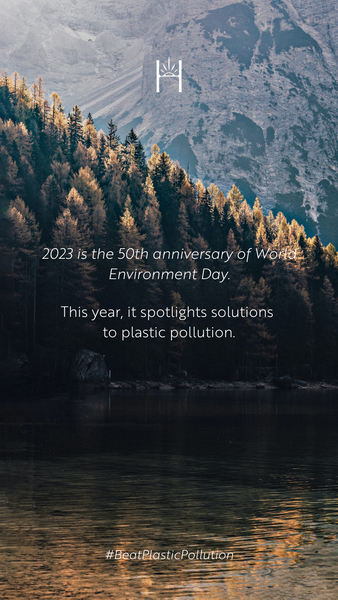World Environment Day

World Environment Day: #BeatPlasticPollution
2023 is the 50th anniversary of World Environment Day. This year, it spotlights solutions to plastic pollution. Our planet is choking on plastic. It is time to change how we produce, consume and dispose of the plastic we use.

There are many things that you as an individual can do:
-Clean a Beach: If you live near a coastline, join beach clean-ups in your area. Or take your family along on a beach walk and start your own clean-up.
-Clean a River: Rivers are direct pathways of plastic debris into the ocean. Join a river clean-up or do your own! The river will look nicer and benefit its ecosystem and the ocean.
-Shop Sustainably: Next time you are out shopping, choose food with no plastic packaging, carry a reusable bag, buy local products, and refill containers to reduce your plastic waste and effect on the environment.
-Try a Zero-Waste Lifestyle: Become a zero-waste champion. Invest in sustainable, ocean-friendly products- reusable coffee mugs, water bottles and food wraps. Consider options like menstrual cups, bamboo toothbrushes and shampoo bars. These will help you save money and the ocean too.
-Travel Sustainably: When you are on holiday, try to watch your single-use plastic intake. Refuse miniature bottles in hotel rooms, take your own reusable drinking bottle.
-Be an advocate for change: Ask your local supermarkets, restaurants and local suppliers to ditch plastic packaging, refuse plastic cutlery and straws, and tell them why. Pressure your local authorities to improve how they manage waste.
-Choose plastic-free personal care products: Personal care products are a major source of microplastics, which get washed into the oceans straight from our bathrooms. Look for plastic-free face wash, day cream, makeup, deodorant, shampoo and other products.
-Dress Sustainably: The fast fashion industry produces 20 percent of global waste water and 10 percent of global carbon emissions. That’s more than all international flights and maritime shipping combined. “Fast fashion” is so last year. Consider sustainable clothing lines and repair your clothes when possible.
Fashion For Earth
Fast Fashion Facts:
-The fast fashion industry produces 150 billion garments a year and 87% end up in a landfill where they smolder and pollute the air or an incinerator.
-Fast Fashion is one of the most polluting of all industries. Clothing is manufactured with highly toxic dyes and heavy metals that are flushed into clean water streams, rivers and aquifers where they sicken people and animals, harm ecosystems, and cause biodiversity loss.
-Up to 40% of fashion’s carbon emissions are from the production of polyester and polyester production is expected to grow by 47% over the next 10 years.
-Washing our synthetic clothing accounts for 35% of all microplastics in the ocean making them the largest source of microplastic pollution in the world’s oceans.
Consumers have the power to change the trajectory of fast fashion! Here are a few important things you can do:
-Educate yourself about sustainable clothing.
-Buy less and shop for quality over quantity.
-Choose natural materials – organic cotton and linen.
-Research brands to identify those that are ethical and practice transparency and sustainability.
-Choose brands that are manufactured in their own community and connected to the place, people behind them, local economy, and environment.

We Believe in Sustainable Fashion
The Handloom aims to reduce our impact on the environment by using sustainable materials that are environmentally friendly and socially responsible. We care about slow fashion principles. Slow fashion is all about simplicity and sustainability. We're committed to creating high-quality garments that are both beautiful and eco-friendly. Our clothes are made from natural materials and feature handcrafted details that make each piece feel special.


